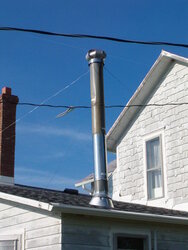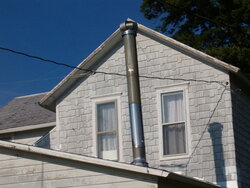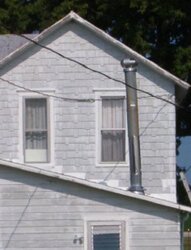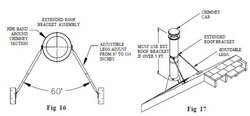Hi everyone – I’m a new member to the forums. However, I have been lurking for a few months and learning much.
I have just had a new Napoleon 1450 installed. I have a concern about my chimney height. The current chimney height is 14 ft. from top of stove to top of outside chimney just below the chimney cap. It goes straight up out of the roof from the stove with no angles. I have triple-wall DuraPlus chimney pipe outside and single wall black stove pipe inside. My chimney cap is a VacuStack because I had backdrafting issues with my old stove when the winds were strong out of the southwest. I had an old 1999 Englander with a small 16” x 16” firebox. It was not EPA technology, just basically a box lined with firebrick. My chimney comes out of the single story part of the house and the second story part of the house is 11 ft. away from the chimney. The chimney is taller than the upper story part of the house except for the peak of the upper story where it is about a foot lower. Everything was fine with drafting until very strong (+40 mph) winds from the southwest which is the direction where the chimney is not taller than the peak of the upper story. In high southwest winds with the old stove, as long as I kept a very hot fire and chimney hot along with adding the VacuStack chimney cap the backdrafting and filling the house with smoke was very minimal.
Ok, so I have this new stove installed and I asked the Napoleon certified installer if I should add length to the outside chimney. I was thinking to add another 2 ft to help with draft and help prevent backdrafting and smoking up the house. (BTW, I am not pleased with the installer as he was very arrogant and when I asked questions he told me I was in information overload.) Anyway, the installer tells me that he doesn’t recommend adding 2 more feet to the chimney because I have the VacuStack chimney cap and that could cause too much draft and overfire the stove. He said I should just see what happens this coming winter. Ok, so that sounds reasonable, but if I do get backdrafting problems I sure don’t want to be up on the roof in the winter trying to install 2 more foot of chimney. And the installer said he would not install more chimney until next spring – if it was necessary. But, if I am going to have slow burns through the night with the stove draft control shut down to low so I can get some sleep at night and not have to get up every 2 hrs to load wood like I did with the old stove, that means the chimney will not be very hot and my thinking is that with high southwest winds I may get backdrafting during the night and wake up to a house full of smoke. Ugh!
So here is my dilemma, do I add 2 ft to chimney height now and risk overfiring the stove because of too much draft or wait until I burn this winter to see what happens? I had read on this forum that some Napoleons are easy to overfire, so I do want to prevent that problem if having too much chimney length combined with the VacuStack cap would cause an overfire. However, if I do have backdrafting problems in high southwest winds with the new Napoleon it means I will not be able to burn during those times, which would suck. Asking for opinions here because I am bouncing back and forth on this issue. And with the installer being so arrogant, I hate to bug him again and be made to sound stupid.
I have posted pics of my outside chimney.
Thanks
I have just had a new Napoleon 1450 installed. I have a concern about my chimney height. The current chimney height is 14 ft. from top of stove to top of outside chimney just below the chimney cap. It goes straight up out of the roof from the stove with no angles. I have triple-wall DuraPlus chimney pipe outside and single wall black stove pipe inside. My chimney cap is a VacuStack because I had backdrafting issues with my old stove when the winds were strong out of the southwest. I had an old 1999 Englander with a small 16” x 16” firebox. It was not EPA technology, just basically a box lined with firebrick. My chimney comes out of the single story part of the house and the second story part of the house is 11 ft. away from the chimney. The chimney is taller than the upper story part of the house except for the peak of the upper story where it is about a foot lower. Everything was fine with drafting until very strong (+40 mph) winds from the southwest which is the direction where the chimney is not taller than the peak of the upper story. In high southwest winds with the old stove, as long as I kept a very hot fire and chimney hot along with adding the VacuStack chimney cap the backdrafting and filling the house with smoke was very minimal.
Ok, so I have this new stove installed and I asked the Napoleon certified installer if I should add length to the outside chimney. I was thinking to add another 2 ft to help with draft and help prevent backdrafting and smoking up the house. (BTW, I am not pleased with the installer as he was very arrogant and when I asked questions he told me I was in information overload.) Anyway, the installer tells me that he doesn’t recommend adding 2 more feet to the chimney because I have the VacuStack chimney cap and that could cause too much draft and overfire the stove. He said I should just see what happens this coming winter. Ok, so that sounds reasonable, but if I do get backdrafting problems I sure don’t want to be up on the roof in the winter trying to install 2 more foot of chimney. And the installer said he would not install more chimney until next spring – if it was necessary. But, if I am going to have slow burns through the night with the stove draft control shut down to low so I can get some sleep at night and not have to get up every 2 hrs to load wood like I did with the old stove, that means the chimney will not be very hot and my thinking is that with high southwest winds I may get backdrafting during the night and wake up to a house full of smoke. Ugh!
So here is my dilemma, do I add 2 ft to chimney height now and risk overfiring the stove because of too much draft or wait until I burn this winter to see what happens? I had read on this forum that some Napoleons are easy to overfire, so I do want to prevent that problem if having too much chimney length combined with the VacuStack cap would cause an overfire. However, if I do have backdrafting problems in high southwest winds with the new Napoleon it means I will not be able to burn during those times, which would suck. Asking for opinions here because I am bouncing back and forth on this issue. And with the installer being so arrogant, I hate to bug him again and be made to sound stupid.
I have posted pics of my outside chimney.
Thanks






